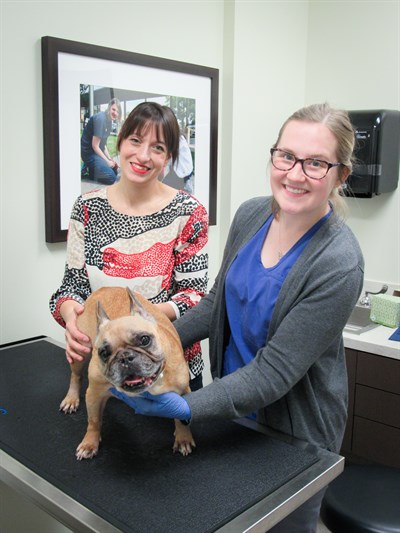Texas A&M, MD Anderson Clinical Trial Helps Dogs, People

Look at Sadie Watson and you may not guess she has much in common with anyone at MD Anderson. After all, Sadie is a 9-year-old French bulldog and beloved family pet. But she’s also facing the same diagnosis as many patients in MD Anderson’s Brain and Spine Center: a brain tumor called a glioma.
Sadie’s owner Kristin Patrick and her husband, Robert Watson, also have two young sons, but Sadie was their “first baby.”
“When you love a pet so much, they become part of your family,” Patrick said.
But in July 2016, while Patrick and Watson were on vacation in Paris, Sadie had multiple seizures and eventually was diagnosed with the glioma.
When it came time for Patrick and Watson to decide how to treat their beloved pet, their perspective as both parents and researchers in the Texas A&M’s Department of Microbial Pathogenesis and Immunology shaped their treatment decision-Sadie would undergo brain surgery to remove the tumor, donate the tissue for analysis, and enroll in an innovative clinical trial on gliomas being conducted at Texas A&M’s College of Veterinary Medicine & Biomedical Sciences (CVM).
“Participating in science is essential to move these therapies forward for families,” Patrick said. “If our actual baby had a brain tumor-I can’t even fathom that.”
The glioma clinical trial, it turns out, will have implications not only on Sadie; the same brain tumors that affect dogs are found in humans, too.
Using data from this clinical trial, physician-scientists from MD Anderson and the CVM are teaming up to help man and man’s best friend.
A Common Bond
“We have the same struggles in that these gliomas in dogs are really hard to treat,” said Dr. Jonathan Levine, professor, Helen McWhorter Chair and department head of Small Animal Clinical Sciences at the CVM, where Sadie is a patient.
Current therapies simply aren’t very effective at treating high-grade gliomas, such as grade IV glioblastoma, and survival is poor in both humans and dogs. Scientists know that tumors from both species look almost identical on MRI scans and under the microscope. In 2015, the National Cancer Institute (NCI) created a comparative brain tumor consortium to evaluate canine brain cancer as a model for human disease.
“The big question is: Are human and canine high-grade gliomas genetically the same?” said Dr. Amy Heimberger, professor of neurosurgery at MD Anderson and co-leader of the Glioblastoma Moon Shot.
To find the answer, she’s leading a P30 grant funded by the NCI. Fittingly, Heimberger is also a dog-lover, with a pet collie named Duke, a west highland terrier named Winston, and a long-haired dachshund named Millie.
Levine and brain tumor genomics expert Roeland Verhaak, Ph.D., professor and associate director of Computational Biology at The Jackson Laboratory in Connecticut, are co-investigators on the grant. (Levine has a border terrier named Lucy. Verhaak has a Chihuahua named Lola.)
The P30 grant is the first large-scale, advanced-sequencing project to characterize genetic alterations in canine glioma and the first screening project to identify immune responses in these tumors. Verhaak is currently analyzing data from whole-genome and RNA sequencing of 90 tissue samples from dogs with brain tumors. The grant’s long-term goal is to develop a safe and effective immunotherapy for both dogs and people with high-grade gliomas.
“These dogs, not only do they stand to benefit, but they represent an amazing opportunity to understand the biology of brain tumors, to understand how tumors evade drugs, and to understand the immune response,” Levine said.
A Better Model & A Shared Hope
All new cancer drugs are tested for safety and effectiveness in the lab-often in engineered mouse models-before they are approved for clinical trials in humans or dogs.
“Pre-clinical studies can look fantastic in mice, but fall apart in humans,” Heimberger said.
For a cancer like glioblastoma, which less than 10 percent of patients survive for five years, this is exceedingly frustrating.
“I want to reduce the cost and futility of clinical trials,” she said. “When you have a patient facing something this dire, you want to offer them something with a good chance of success.”
The current model system is imperfect: mice do not grow brain tumors on their own. Their tumors are small, sometimes microscopic. They live in a sterile environment. And their immune response is biased, making it difficult to accurately assess immunotherapies.
Pet dogs, on the other hand, spontaneously develop large brain tumors. They have a natural immune response to cancer, and they live in the homes of their human families.
As the grant team analyzes the tumor tissue samples from Sadie and other dogs, they will look for genetic mutations and immune responses known to occur in human brain tumors. If the results show that canine brain tumors are indeed a good model for human brain tumors, then clinical trials in man’s best friend could reveal which new glioma immunotherapies have the best chance of success in mankind.
“Cancer is horrible for anyone affected by it, whether that’s a dog or a person,” Levine said. “There’s a huge opportunity here to develop something that helps dogs and also helps people.”
This story, by Meagan Raeke, first appeared in MD Anderson’s Conquest magazine. The original article can be viewed here.


